Offices and Labs - Connecting to the wired network (Windows 11)
If you haven't already, then start by submitting a network request. Once you have, we'll email you with important configuration information.
There are 6 steps required to configure your Windows computer to connect to the wired network (click each box to expand):
1. Turn on your computer and log in as Local Administrator account
Log on to an account that has administrative rights.
Note: Usually this account is called Administrator but it may have a different name. If an account does not have administrative rights, you will not be able to proceed. The password may be blank. New computers out of the box will log on automatically with the Administrator account as the password will be blank.
2. Connect your computer to a live network point
- Make sure that there are no signs of physical damage on the port, and that the network cable is not damaged.
- Using a network cable, connect the computer to a network point located nearby. Make sure there is no trip or other health and safety hazard. After you connect the cable, you should see activity lights at the back or on the side of your machine, near the network point.
- Back on your computer, check if you can display Trinity home page www.tcd.ie. You can use any browser you have installed.
Note: For more information about network points and cables please visit the linked page. If you are stuck at this point, there may be some hardware or configuration problems. If you need assistance, please contact IT Service Desk at ext. 2000.
3. Rename your computer and join the college domain
- Using the Search button (magnifying glass) in the bottom of the screen, type Advanced system settings

- Choose View advanced system settings under Best match
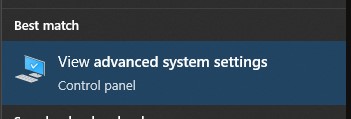
- Click the Computer Name tab, and then click Change.
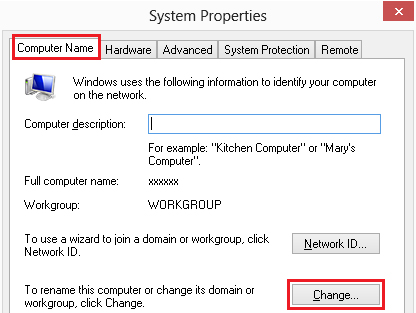
- In the Computer name box, type the computer name provided by IT Services.
In the Member of section, select Domain, and type college.tcd.ie, then click OK.
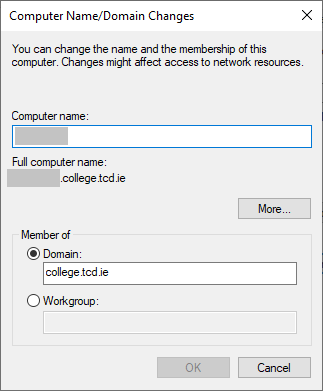
- You will be prompted for your Trinity username and password. Type your username in the form college\username, then type your password and click OK.
- After a few moments a 'Welcome to the college domain' message will appear. Click OK and select ‘RESTART LATER’ so that you can proceed to the next Step for setting administrative access.
4. Set administrative access and password for Local Administrator account
- Using the Search button (magnifying glass) in the bottom of the screen, type Computer Management

- Choose Computer Management under Best match

- On the left-hand side of the Computer Management window, click the triangle next to Local Users and Groups to expand that list

- Click Groups
- On the central panel, right-click Administrators and select Properties
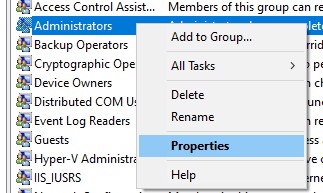
- Click Add
- In the Enter the object names to select box, type your Trinity username in the form college\username and click Check Names.
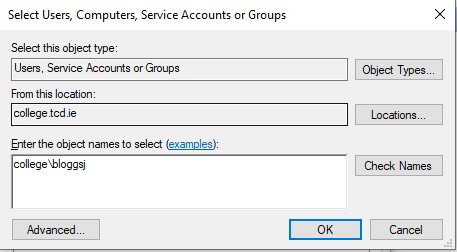
You will be prompted for your Trinity credentials. Type college\username and your password, then click OK. - Add Users to Administrator Group
- Repeat the previous step to add IT Services admin group college\issgroup1. Repeat the previous step to add any other Trinity users that you wish to add as Administrators on the machine.
- Click OK, then click Apply. Keep Computer Management open and proceed to set the local Administrator password as follows.
- Click on Users, Right click on Administrator and choose the option to Set Password. Pick a password of your own choosing. The password you set will be what’s known as the local administrator password.
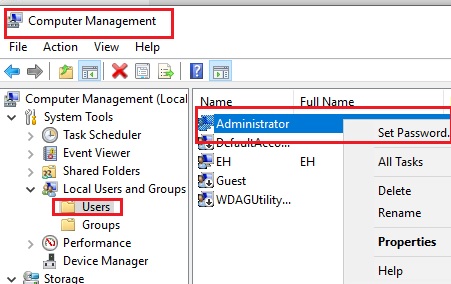
Local administrator passwordThe local administrator password is specific to the device and will not change. Keep a secure record of this password as it may need to be passed on to another user of your department should the device be inherited. IT Services will not have a record of this password.
- Close the computer management window and Restart your computer
5. Log on to your Trinity profile
- Log off the Local Administrator Account. To do that press Ctrl+Alt+Del on your keyboard and select Sign out.
- On the log on screen, press Ctrl+Alt+Del, then click OK.
- Click Other User.
- Log on with your Trinity username and network login password. You are now logged on to your Trinity profile.
Note: Logging on to your Trinity profile is a requirement while you are connected to the Trinity network. It also provides a better user experience and facilitates access to Trinity resources and services.
6. Ensure your computer meets Trinity security policies
- Make sure anti-virus software is installed and up to date
- All PCs ordered from the official Trinity suppliers come with McAfee Endpoint Security software installed. You will know if Endpoint Security has been installed, as you will see the Trellix icon in the taskbar at the bottom right corner of the screen

- If you think you have Endpoint Security installed but you don’t see the ‘vshield’ icon, then select the Start button and choose All apps and look for McAfee – Endpoint Security
- If you have a different Anti Virus product installed, you will be required to uninstall it and install McAfee Endpoint Security. Click the anti-virus software link above for more information.
- All PCs ordered from the official Trinity suppliers come with McAfee Endpoint Security software installed. You will know if Endpoint Security has been installed, as you will see the Trellix icon in the taskbar at the bottom right corner of the screen
- Make sure Microsoft Endpoint Configuration Manager (MECM) Agent is installed. To get automatic monthly Windows security updates please follow our instructions for installing the MECM Agent.
- Contact the IT Service Desk to complete the security checks.
- Once you have performed the above tasks please contact the IT Service Desk at ext. 2000 and quote your ticket number. The IT Service Desk personnel will go through some further security checks before closing your request.
(Optional) Arrange data transfer with the IT Service Desk
If you wish to transfer data from another PC to your newly connected PC please see our web page on data transfer between two PCs on the Trinity network or, if you require assistance, contact the IT Service Desk.

